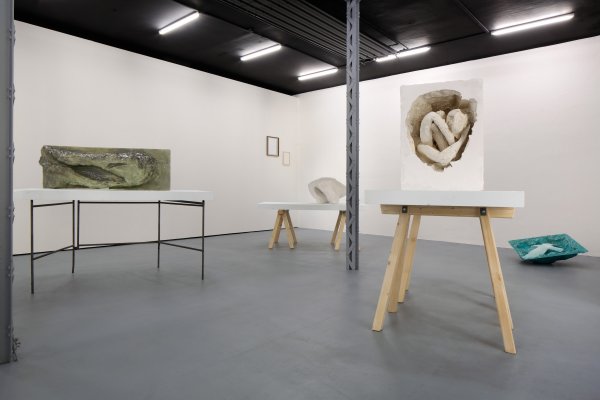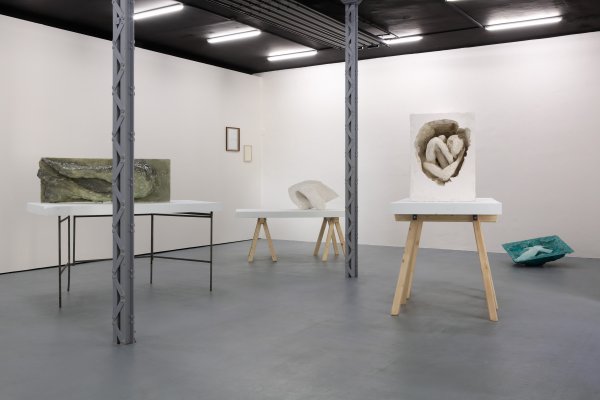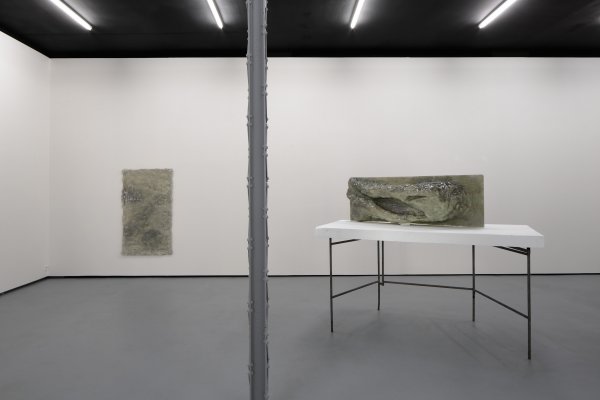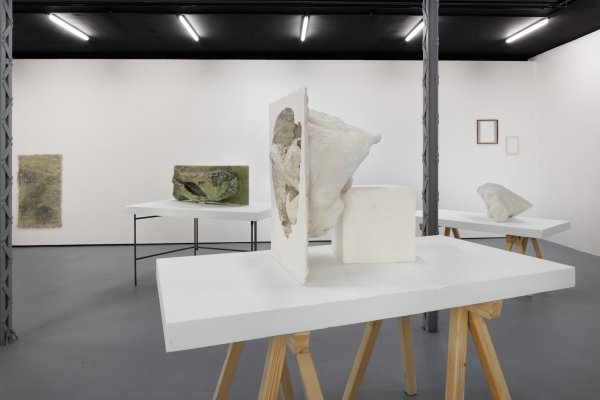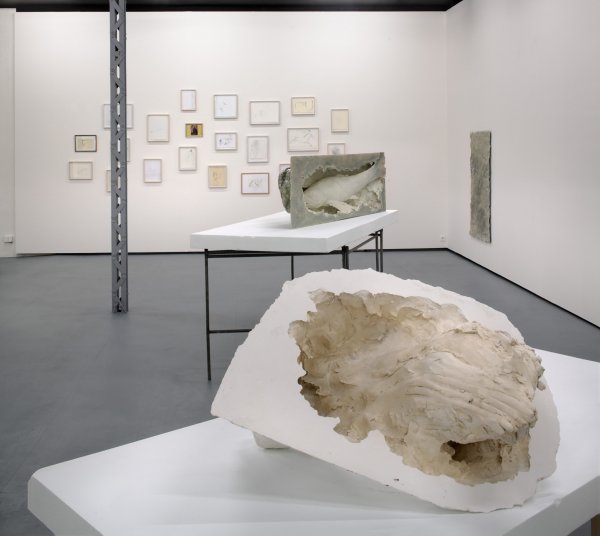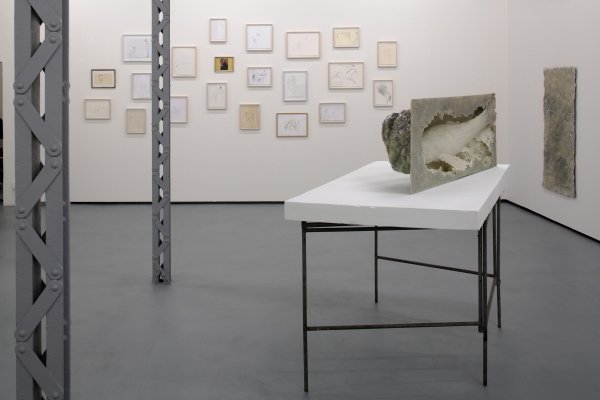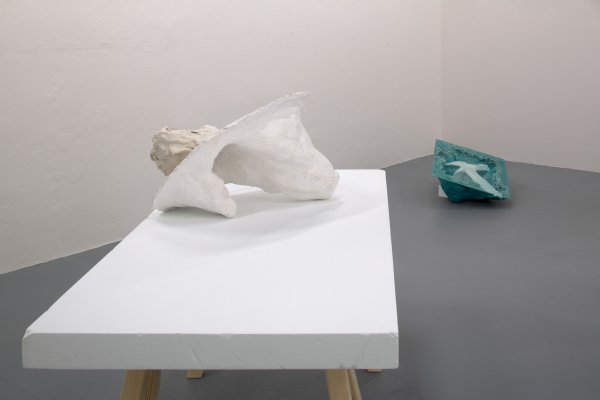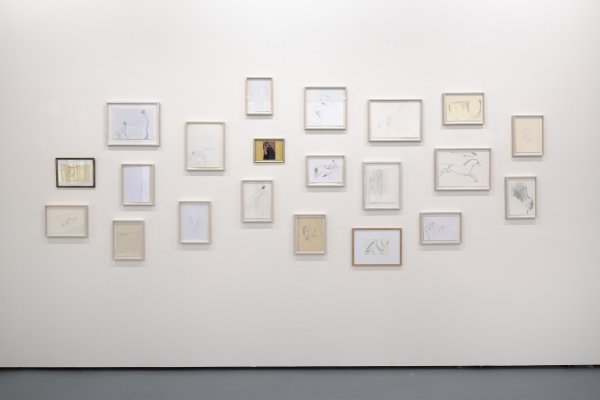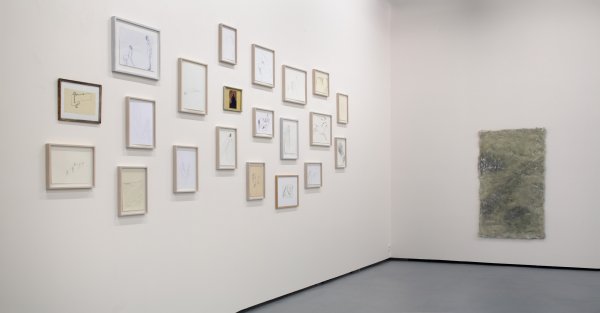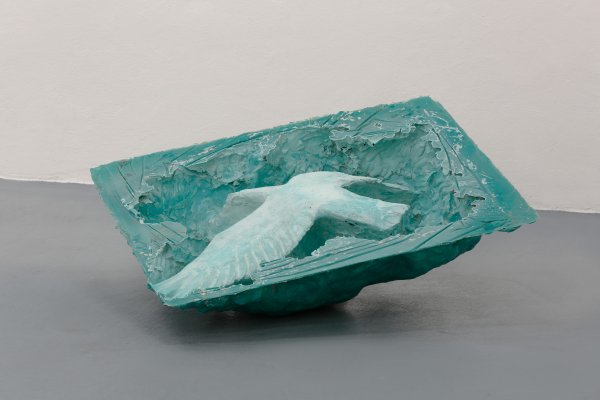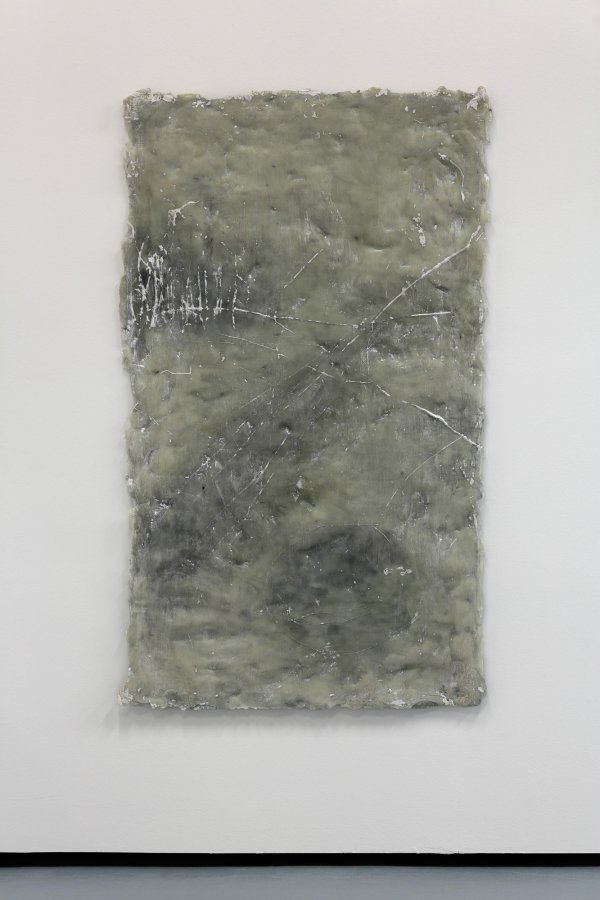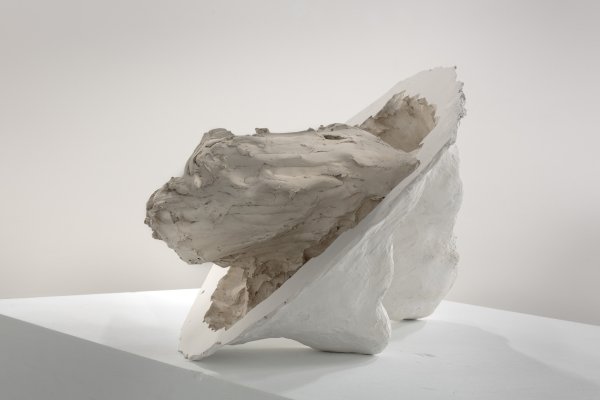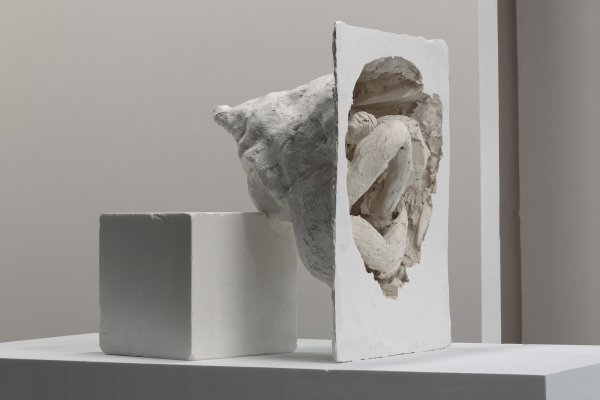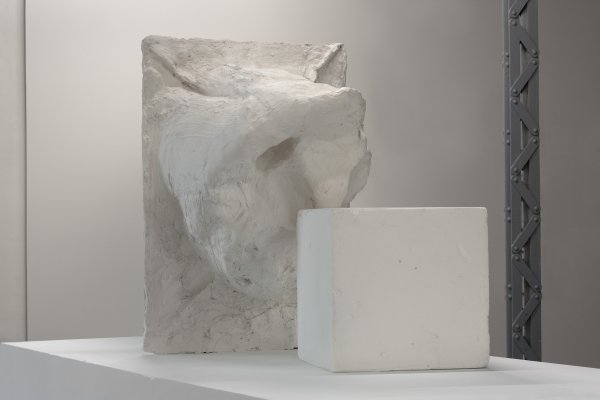Quirin Bäumler
Rhymes and Couplets
11.4.2015–23.5.2015 Prague- Text by Thomas Groetz (EN)
- Text by Thomas Groetz (DE)
- Text by Thomas Groetz (CZ)
Encased – Urged to life
*Art supports the best that man is capable of – faith, love, beauty, reverence or what is dreamt of or hoped for. If a non-swimmer plunges into the water, his body, not he himself, starts to make instinctive movements to save him. Art also is something like a human body thrown into the water – it exists as an instinct that does not let mankind drown in a spiritual sense.
Andrei Tarkovsky*
Quirin Bäumler produces drawings and sculptures. Both media exist and develop parallel and independent from each other – as individual strands with all their autonomy. Despite of this essential difference there are underlying correspondences, similarities and connections between the two separate modes of expression.
The drawings at first glance appear in a diverse and multiform way, and can be perceived as a spontaneous and instant outflow. Considered as immediate, sometimes volatile or even seemingly incidental notations, they are realized by means that were at hand: pencil, ball or ink pen, executed on different sorts of paper, some of them of various age. Comparably diverse are the ways of execution that oscillate between an emphatic weave, a self-assuring outline and a fragile, even timid expression.
What Quirin Bäumler is drawing and depicts is not abstract, is not a document of any ostensible interest in formal structures, like geometrical, dense or minimalist statements, but is aiming at something substantial and intrinsic. The drawings manifest themselves as spontaneous and immediate images. Lines seem to pop up out of some un- or pre-consciousness or a nonbeing, as a sudden projection, that immediately builds out something anthropomorphic and creature-like. Out of succinct, interrupted strokes the spread wings of a bird emerge, in a kind of psychic automatism. Creatures – human beings and animals – appear on the image surface, manifest themselves, urge into existence. This urging, the ´drama´ of life and the state of development of beings, combined with questions or possibilities of growth, seems to be a, if not the fundamental subject in Quirin Bäumlers art, that is present in his drawings as well as in the sculptural work.
Another central motive that appears in the drawings is the topic of contact, the encounter; it is the single, the individual, where something second is added to: his supplement, his completion, or even his questioning in the form of communing or doubling, as his counterpart or his threat. The human being in his hubris is shown as a tragic Narcissus who mirrors himself by the dynamics of an invisible ascending diagonal as an animal; a creature is exposed that admits respectfully or capitulating his animal nature; the human (man) who threatens the other (woman) in his urge of coupling or an alleged unification; the dependent child that with a conflicting expression, with at the same time loving and fearfully widened eyes contacts someone else (his mother); the bird that approaches a geometrically simplified human being-surrogate in an explicit threat.
In the course of the great and nearly contradictory tension or range between contact, encounter, menace and collision the fragmentary, merely indicated, disparate and abysmal appears. Oppressive to grotesque human-being-animal-metamorphoses are taking place. It is a context where elements and spolia of the different languages of modernism appear as fragments: cubic and cubist conglomerates, surreal lengthenings and liquefactions, Paul Klees or Alfred Kubins ludicrous gaze at the bent and headless human is hinted, Wilhelm Lehmbrucks existential studies on the anonymous, paradigmatic being-thrown-into-the-world of the alleged crown of creation flare up – though not as postmodern, distant, ironic quotations or even stylistic bonds, but as reminiscences and memories of the collective subconscious, chaotic formal repertoire of the 20th Century; a to a large extent solipsistic style-exegesis, that was not able to deliver much news concerning the dealing or even the coping with the tragic conflict of the human race.
A desperate if not at all hopeless situation of man, that inter alia results in the tension between his enormous possibilities and the fact of being trapped in himself, can be felt also in Quirin Bäumlers sculptures. Their white, colorless, neutralized, but at the same time concrete and naturalistic forms appear from the obscure and unclear, they are virtually drawn out of a nothingness. The artist models his figurations not (as usual) as a positive, but as a negative form by carefully hollowing out blocks of material. The molding brings the positive form to light, leaving the negative form behind.
Similar to the drawings, where the creatureness serves noticeable as a guideline, the sculptures not only show the actual, but the metaphorical “naked” emerging and emerged life. They are virtually exemplified birth processes that release the view on the growing seed, the young crop, the organic growing up to lifelike creatures as fishes, birds, owls, who spread their wings confirming their being. Also humans appear – as reduced, seemingly androgynous, anthropomorphic living things, depicted in a childlike innocence, whose own existence still needs to be proven.
Bäumlers figurations still drag the “slag” of their formation with them, they are not peeled from the egg, but rather raw and undressed, still partly wrapped with placenta, not yet fully split off material, a kind of primeval stuff. The sculptured beings spring from and at the same time exemplify a peculiar field of energy with their open, urged to life, but also encased, wrapped, shut off and encapsulated forms. These contrarily movements refer to the contractions of the emerging and growing. Inside and outside, arising and disappearing, statement and withdrawal are connected to and related with each other, are nested, seem to be mirror-related to each other and in this way aim to clarify the logic of creation, that is determined by a puzzling coincidence of opposed energies and forms of existence.
Quirin Bäumler invokes and conjures the forces that are pulling man down or lifting him up. With his creations the artist refers in a direct and un-mannered way to the necessity of rising, a central motive of incarnation, of being human. Bäumlers sculptures and drawings embody both – a nearly contradictory and at times seemingly grotesque carefree tragic and desperation in the face of weakness, failing and existential forlornness, but at the same time the potency and possibility of development.
*Abgekapselt – ins Leben drängend
Die Kunst bekräftigt jenes Beste, zu dem ein Mensch fähig ist – also Glaube, Liebe, Schönheit, Andacht oder das, was man sich erträumt oder erhofft. Wenn sich ein Nichtschwimmer ins Wasser stürzt, dann beginnt sein Körper, also nicht etwa er selbst, instinktive Bewegungen zur Rettung seiner selbst zu machen. Auch die Kunst ist so etwas wie ein ins Wasser geworfener Menschenkörper – sie existiert als ein Instinkt, der die Menschheit im geistigen Sinne nicht ertrinken lassen will.
Andrej Tarkowskij, Die versiegelte Zeit*
Quirin Bäumler ist Zeichner und Bildhauer. Beide Medien existieren parallel und unabhängig voneinander – als unterschiedliche Stränge mit all ihren Eigengesetzlichkeiten. Trotz dieses Wesensunterschieds gibt es tiefer liegende Korrespondenzen, Gemeinsamkeiten und Verbindungen zwischen zwei materiell andersartigen Ausdrucksweisen.
Die Zeichnungen treten als spontane und unmittelbare Ausflüsse in Erscheinung, sie sind schnelle, manchmal flüchtig oder fast beiläufig wirkende Notate, realisiert mit Mitteln, die gerade zur Hand waren: Bleistift, Kugelschreiber, Tintenstift auf verschiedenste Zeichengründe wie Zettel, vergilbte oder gebräunte Papiere. Ähnlich vielgestaltig ist auch die Art der Artikulation. Sie pendelt zwischen nachdrücklichem Geflecht, sich selbst-vergewissernder Kontur und einer unruhig-nervösen bis zaghaft-brüchigen Linienschrift.
Das, was Bäumler zeichnet, darstellt, ist nicht abstrakt, dokumentiert kein vordergründiges Interesse an formalen, etwa geometrischen, verdichteten oder minimalistischen Strukturen, sondern zielt ab auf etwas Wesentlicheres, Wesenhaftes. Die Zeichnungen offenbaren sich als spontane, unmittelbare Bildfindungen; Linien schiessen unvermittelt aus einem Un- oder Vor-Bewussten, bzw. ihrem Nicht-Sein ins Bild, als jähe Projektionen, die sich sogleich anthropomorph und wesenhaft ausgestalten. Aus lapidaren, unterbrochenen Strichfolgen entwickeln sich in einer Art psychischem Automatismus die ausgebreiteten Schwingen eines Vogels. Lebewesen – Mensch und Tier – tauchen auf, stellen sich auf der Bildfläche ein, drängen in die Existenz. Die Tatsache, das Drama ihrer Erscheinung sowie der jeweilige Entwicklungszustand der Wesen, sind – verbunden mit der Frage der Entwicklungsmöglichkeiten – ein, wenn nicht das wesentliche Thema in Quirin Bäumlers Kunst, das sowohl den inhaltlichen Rahmen der Zeichnungen als auch den der Skulpturen bestimmt.
Ein diesem untergeordnetes, aber ebenso zentrales Motiv bzw. Sujet der Zeichnungen ist der Kontakt, die Begegnung; das Einzelne, zu dem etwas Zweites hinzutritt: seine Ergänzung, Vervollkommnung, oder seine Infragestellung als Verdopplung und Zwiesprache, als Bedrohung oder sein Gegenpart. Der Mensch ist zu sehen, der sich in seiner Hybris, aber zugleich als tragischer Narziss an einer gedachten, dynamisch aufsteigenden Diagonale unvermittelt als Tier spiegelt; das Wesen, das sich ehrerbietig bis kapitulierend seine Tier-Natur eingesteht; der Mensch, der zu vermeintlicher Vermählung drängend den oder das Andere bedroht; das abhängige Kind, das zwiespältig, mit zugleich liebevoll und ängstlich geweiteten Augen Kontakt zu einem Anderen, zu seiner Mutter aufnimmt; der Greifvogel, der sich mit geöffnetem Schnabel in expliziter Bedrohung einem geometrisch vereinfachten Menschen-Surrogat nähert.
Im Zuge der grossen und beinahe widersprüchlichen Spannung und Spannweite zwischen Kontakt, Begegnung, Bedrohung und Kollision tritt auch das Fragmentarische, bloss Angedeutete, Disparate, Bruchstückhafte und Abgründige auf. Bedrückende bis groteske Mensch-Tier-Metamorphosen sind im Gange; Elemente und Spolien aus den Sprachweisen der Moderne treten in diesem Kontext bruchstückhaft auf: kubische bis kubistische Konglomerate, surreale Dehnungen und Verflüssigungen, Paul Klees oder Alfred Kubins groteske Blicke auf den gebeugten bis kopflosen Menschen klingen an, Wilhelm Lehmbrucks existenzielle Untersuchungen über das anonyme, paradigmatische In-die-Welt-geworfen-Sein der vermeintlichen Krone der Schöpfung blitzen auf – allerdings nicht als postmoderne, distanzierte, ironische Zitate, oder gar Stil-Anleihen, sondern als Reminiszenzen und Erinnerungen aus dem kollektiv-unbewussten, chaotischen Form-Programm des 20. Jahrhunderts, eine zu weiten Teilen solipsistische Stilexegese, die zum Umgang mit, oder gar zur Bewältigung der Tragik des Mensch-Seins, wenig Neues hat beisteuern können.
Spürbar wird die verzweifelte, wenn auch nicht hoffnungslose Tragik des Menschen, die unter anderem in der Spannung zwischen seinen enormen Möglichkeiten und seiner Gefangenheit in sich selbst besteht, auch in Quirin Bäumlers Skulpturen. Deren einerseits neutralisierte, weisse, unfarbige, aber zugleich konkrete und lebensnahe Formen entstehen auf ihre Weise ebenso aus dem Ominösen, Unklaren, werden quasi aus dem Nichts hervorgeholt. Der Künstler modelliert seine Figuren nicht als Positiv, sondern als Negativ, indem er unförmige Materie-Blöcke sorgfältig aushöhlt. Erst ein Ab- bzw. Ausguss bringt das Positiv – die Erscheinung – ans Licht.
Ähnlich wie die Zeichnungen, wo das Kreatürliche als Leitlinie spürbar ist, zeigen die Skulpturen noch nachdrücklicher das nicht nur tatsächliche, sondern auch metaphorisch ´nackte´, entstehende und entstandene Leben. Sie sind quasi veranschaulichte Geburtsvorgänge, die den Blick frei geben auf die keimende Saat, auf organisches Wuchern, bis hin zu naturalistisch entwickelten Lebewesen wie Fischen, Vögeln, Eulen, die ihre Schwingen mächtig, ihre Existenz bekräftigend ausbreiten, sowie auf oft verkleinerte, androgyn wirkende, in kindlicher Unschuld dargestellte anthropomorphe Wesen, deren Eigenexistenz sich noch erweisen muss.
Bäumlers Figuren schleppen die Schlacke ihrer Entstehung mit sich herum, sind nicht aus dem Ei gepellt, sondern roh, umhüllt noch von der Plazenta, noch nicht vollständig abgespalten von Material, einer Art Urmaterie. Die modellierten Wesen entspringen selbst und veranschaulichen zugleich ein eigentümliches Kräftefeld von sich öffnenden, ins Leben drängenden, aber auch umhüllten, sich verschliessenden und sich entziehenden, abgekapselten Formen. Diese konträren Bewegungen verweisen auf die Kontraktionen des Entstehens und Werdens. Aussen und Innen, Entstehen und Verschwinden, Äusserung und Zurücknahme sind miteinander verbunden, sind verschachtelt, scheinen vexierbildlich aufeinander bezogen zu sein und verdeutlichen so die Logik des Schöpferischen, zu der stets ein rätselhafter Ineinsfall gegensätzlicher Kräfte und Existenzformen gehört.
Quirin Bäumler beschwört in seiner Kunst die den Menschen hinabziehenden oder ihn empor-reissenden Kräfte. Der Künstler verweist mit seinen Schöpfungen auf eine direkte, un-manierierte Weise auf die Notwendigkeit des Sich- Aufrichtens, einem zentrales Motiv der Menschwerdung. Die Skulpturen und die Zeichnungen Bäumlers verkörpern beides, eine fast widersprüchlich und gelegentlich grotesk anmutende, unbeschwerte Tragik und Verzweiflung angesichts von Schwäche und existenzieller Verlorenheit, aber zugleich das Potential menschlicher Entwicklungsmöglichkeiten.
Zapouzdření - Puzení k životu
*Umění podporuje to nejlepší v člověku - víru, lásku, krásu, posvátnou úctu a vše, o čem sní nebo v co doufá. Pokud se neplavec vrhne do vody, jeho tělo, nikoli on sám, začne vykonávat instinktivní pohyby ve snaze zachránit se. Umění je v tomto aspektu podobno lidskému tělo vrženému do vody - existuje jako určitý instinkt, který nenechá člověka utopit se v duchovním slova smyslu.
Andrej Tarkovsky*
Quirin Bäumler tvoří kresby a plastiky. Obě tato média existují a vyvíjejí se paralelně a nezávisle jedno na druhém - jako samostatné, plně autonomní proudy. Navzdory této základní odlišnosti však nacházíme také v hloubce ležící podobnosti a spojitosti mezi těmito dvěma oddělenými způsoby vyjadřování se.
Jeho kresby se mohou na první pohled jevit jako různorodé a mnohotvárné a budit dojem spontánního a okamžitého tvůrčího toku. Tyto bezprostřední, často až těkavé motivy nebo dokonce i zdánlivě nahodilé projevy jsou tvořeny s využitím čehokoli, co bylo zrovna po ruce: tužka, kuličkové nebo plnicí pero, jako podklad slouží různé druhy papíru často i různého stáří. Obdobně různorodé jsou i způsoby provedení, které oscilují od výrazných vinutých linií přes sebejisté obrysové linie až po křehké, téměř plaché výrazivo.
To, co Quirin Bäumler zachycuje ve svých kresbách, není abstraktním vyjádřením, nejedná se o projev zájmu o formální struktury, jako jsou geometrická, zhuštěná nebo minimalistická témata, usiluje spíše o vyjádření něčeho reálného, vnitřního a ze samotné podstaty plynoucího. Jeho kresby budí dojem spontánních a bezprostředních obrazů. Linie jakoby vyskakovaly z určitého nevědomí, předvědomí nebo stavu nebytí, jako náhlé projekce z těchto světů, které okamžitě začínají tvořit cosi antropomorfního, živým bytostem podobného. Ze strohých, přerušovaných tahů se rodí rozpjatá ptačí křídla, jakoby šlo o automatickou kresbu. Bytosti - lidé a zvířata - vyplouvají na povrch obrazů, projevují se zde, puzeni k vlastní existenci. Toto puzení, toto drama života a momentálního stavu vývoje bytostí v kombinaci s otázkou možnosti dalšího růstu se jeví významným, možná i základním motivem, který u Quirina Bäumlera nalézáme, a to jak v jeho kresbách, tak plastikách.
Dalším velmi významným motivem objevujícím se v jeho kresbách je téma kontaktu a setkávání: moment kdy jedinci je přidáno cosi dalšího - jeho doplněk, něco, co jej završuje nebo naopak zpochybňuje formou souznění nebo zdvojení, jako jeho protipól nebo dokonce hrozba. Člověk ve své aroganci je znázorněn jako Narcis, jež se zrcadlí dynamikou neviditelné stoupající diagonály jako zvíře - je tak odhalena bytost, která se s hrdostí hlásí nebo možná jen kapituluje před svou zvířecí podstatou. Člověk (muž) hrozící jinému člověku (ženě) ve své touze po fyzickém spojení a duševním splynutí. Dítě, bytost závislá na dospělých, s výrazem odrážejícím vnitřní emoční konflikt, oči dokořán plné láskyplné něhy a zároveň strachu z kontaktu s někým jiným (jeho matkou). Pták blížící se ke geometricky zjednodušené lidské figuře jako výraz nepokryté hrozby.
V průběhu tohoto úchvatného a místy až protichůdného pnutí mezi kontaktem, setkáváním, hrozbou a kolizí se objevuje rovina roztříštěnosti, náznaků, nesourodosti a propastnosti. Dochází k chmurným až groteskním metamorfózám lidská bytost - zvíře. Jedná se o kontext, ve kterém se objevují prvky a ukořistěné fragmenty různých řečí modernismu: kubické a kubistické slepence, surreálná prodloužení a zkapalnění prvků, odkaz na nevěřícný výraz tváře Paula Kleese nebo Alfreda Kubinse zírajících na zohýbanou, bezhlavou lidskou bytost, ožívají existenciální studie Wilhelma Lehmbrucka o anonymnosti a motivu vržení do existence z údajného nejvyššího vývojového stupně stvoření, avšak nikoli jako postmoderní, odtažité, ironické citace nebo stylistická propojení, nýbrž jako odkazy a vzpomínky na kolektivní podvědomí, chaotický formální repertoár 20. století a do velké míry solipsistický rozbor stylu, který nebyl schopen poskytnout mnoho nového, co se možnosti vypořádat se s tragickým konfliktem lidské rasy týče.
Také z plastik Quirina Bäumlera cítíme zoufalou až beznadějnou situaci člověka, která vede mimo jiné k pnutí mezi obrovským spektrem jeho možností a faktem, že je chycen v pasti sebe samého. Jejich bílé, bezbarvé, neutralizované, avšak zároveň konkrétní a naturalistické formy se objevují na pozadí skrytého a nejasného. Jsou doslova vytahovány ven z nicoty. Své plastiky nevytváří umělec běžným, řekněme pozitivním způsobem. Používá negativní nebo, chcete-li, obrácenou techniku, kdy tvary a formy pečlivě hloubí do bloků materiálu. Toto tvarování pak vynáší pozitivní formy na světlo a negativní hmotu ponechává na pozadí.
Obdobně, jako je tomu u jeho kreseb, i zde je evidentní, že bytostnost slouží jako jakési vodítko. Jeho plastiky nezachycují jen to skutečné, ale i to metaforicky „nahé“ - vynořující se a již vynořený život. Jsou ve své podstatě ztělesněním procesu zrodu a nabízejí pohled na klíčící semena, rašící život, organický růst a vývoj až do bytostí, jako jsou ryby, ptáci, sovy, které svými roztaženými křídly stvrzují svou existenci. Objevují se zde i lidé - jako redukované, zdánlivě androgenní, antropomorfní bytosti zobrazené s nevinnosti dítěte, jehož vlastní existence musí být teprve prokázána.
Bäumlerovy figury s sebou nesou prvky odkazující na proces vlastního zrodu, nejsou úhledně vylíhnuté z vajec, spíše se dají popsat jako syrové a neupravené, stále ještě částečně pokryté placentou, materiálem, který se doposud zcela neoddělil, jakousi primární hmotou. Bytosti se vynořují ze zvláštního pole energie, které současně ztělesňují, jejich formy jsou otevřené, puzené k životu, zároveň však uzavřené ve svých schránkách, oddělené a jakoby zapouzdřené. Tyto protichůdné prvky odkazují na kontrakce vynořujícího se a rostoucího. Dovnitř a ven, vzestup a zanikání, sdělení a stažení se jsou vzájemně propojeny v téměř zrcadlovém vztahu k sobě navzájem, čímž se snaží objasnit logiku stvoření a tvorby, které probíhají na základě matoucího spolupůsobení protichůdných energií a forem existence.
Quirin Bäumler zachycuje a vyvolává síly, které člověka strhávají k zemi nebo povznáší vzhůru. Svojí tvorbou odkazuje přímým a nevyumělkovaným způsobem na nezbytnost vzestupu a růstu, na tento ústřední motiv inkarnace a lidství. Bäumlerovy plastiky a kresby v sobě nesou obojí - téměř protichůdnou a místy zdánlivě groteskně bezstarostnou tragičnost a zoufalství tváří v tvář slabosti, pádům a existenciální opuštěnosti, avšak zároveň i potenciál a možnost růstu a vývoje.
